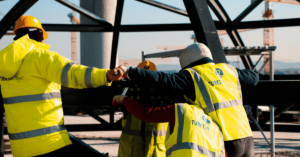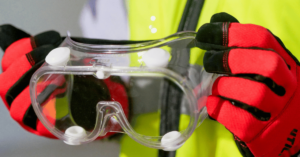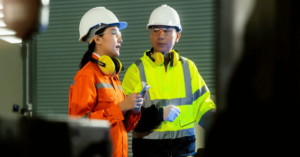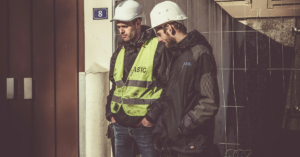Work-from-home (WFH) culture has single-handedly reshaped the future of business operations, for both better and worse.
In 2023, 473,000 UK workers were reported to suffer from work-related musculoskeletal disorder (MSD)—a health condition affecting nerves, muscles, and tendons—made worse by amateur workspace setups. This is an increase of 3,000 cases from the previous year.
Although working from home is more flexible, improves work-life balance, and is cost-effective, it can raise severe employee health and safety concerns. With over 40% of employees in the UK working remotely today, conducting a periodic working from home risk assessment is crucial for employers, now more than ever.
This blog offers a comprehensive overview of home working risk assessments, including their purpose, how and who can carry out risk assessments, and their core benefits to both companies and employees.
Ready to train your staff to be safe and healthy when working remotely? Enrol today in TSW Training’s NEBOSH-accredited Health and Safety courses, designed to safeguard businesses and workers in today’s fast-changing workplace culture.
What is a Home Working Risk Assessment?
According to the Health and Safety at Work Act 1974, it’s every employer’s responsibility to safeguard their remote workers’ health, safety, and well-being. On that note, a working from home risk assessment is a structured process for identifying and assessing potential hazards in an employee’s remote workplace.
The HSE’s survey data reveals that in 2022-23, 23.7 million working days were lost in Great Britain due to work-related MSDs (16.1 million days) and stress, anxiety, or depression (6.6 million days). These issues can be proactively addressed by conducting a home working risk assessment to detect possible stressors and ergonomic risks in home working setups.
How Often Should Home Working Risk Assessments Be Reviewed?
Home working risk assessments are ongoing processes, not a one-time event. Employers are legally obligated to conduct regular assessment reviews, especially in scenarios such as the following:
- Job roles or workload-related changes
- Installation of new hardware, like a computer display or a desk chair
- Changes made to the home office setup
- Personal events that affect the workplace, e.g., new housemates, renovation, etc.
As companies are responsible for their staff’s well-being, arranging reviews helps verify the relevance of their working from home risk assessments.
What Are Safe Work Practices at Home?
Generally, working from home sounds like a very low-risk work culture compared to on-site. However, research from the Royal Society for the Prevention of Accidents (RoSPA) reveals that more accidents occur at home than anywhere else, averaging around 6,000 deaths per year.
On that note, here are some important areas to consider for safe work practices in a home workplace:
Ergonomics (While Working on a Computer)
Creating a dedicated workspace with a comfortable chair, an adjustable desk (not mandatory), and a monitor at eye level is important for workers to maintain good posture during work hours. This practice dramatically lowers the risk of MSD disorders, such as back pain, neck strain, and repetitive strain injury.
Work-related Equipment Safety Checks
Don’t overload plug outlets with extension cords, and ensure all work-related electrical equipment is PAT (Portable Appliance Testing) inspected. Identify your home’s fire escape routes and ensure they are unobstructed. Keep a fire extinguisher close at hand, and test smoke alarms regularly.
Mental Wellbeing Practices for Workers
Working remotely can be stressful. Protecting employee mental health is a key step in establishing a safety culture in the workplace, whether it’s remote or on-site.
As an employee, you should familiarise yourself with the policies and resources the firm offers if you choose to work from home.
Stay engaged with coworkers, talk openly with your management, take breaks during the day, and use your vacation time for your mental well-being. Set a regimen and avoid working outside your designated hours.
DSE (Display Screen Equipment) Protection
As per law, employers must protect their workers from Display Screen Equipment-related health risks, primarily caused by overusing computers, laptops, and mobiles.
While working remotely, take regular pauses from screen work, perform eye exercises, and maintain good posture to reduce the risk of eye strain and other DSE-related disorders.
Who Carries Out Risk Assessments While Working From Home?
According to the Health and Safety Act at Work Act 1974, employers are responsible for undertaking risk assessments for home working settings. Employers must also conduct a comprehensive work-from-home risk assessment under the Management of Health and Safety at Work Regulations 1999.
Note that employees are occasionally required to participate, e.g., by following clear instructions and checklists given by companies to self-assess their home workspace. At the end of the day, the employer is still responsible for the ultimate risk assessment review and approval.
Not sure where to begin? Connect with us at TSW Training today to protect your staff from remote working risks with our Health and Safety training courses.
Types of Home Working Risks and Hazards
As discussed, MSDs caused by prolonged sitting, improper posture, and inadequate workstation ergonomics remain the most common health risks associated with remote working.
On that note, here are five other common risks associated with working from home in a nutshell:
1. Slips, Trips, and Falls
The risk of slips, trips, and falls (caused by uneven flooring, wiring, cluttered workspaces, etc.) causes serious injuries. In 2022, these incidents led to 30% of all non-fatal workplace accidents.
2. Eye Strain
Extended periods of gazing at screens without taking breaks can cause eye strain, headaches, and impaired vision.
3. Electrical Hazards
Risks of shock or fire can arise from inadequately maintained electrical equipment, overloading circuits, and mishandling extension cords. In 2022, Great Britain alone witnessed over 335 fatalities caused by fire.
4. Emotional & Psychological Health Risks
Difficulties turning off from work, loneliness, and social isolation can all have a detrimental effect on one’s mental and emotional health.
5. Privacy and Data Security
Phishing schemes, weak data protection protocols, and unsecured Wi-Fi networks can jeopardise confidential company data. UK citizens lose an average of £1,169 every year, falling victim to cybercrime.
Now, let’s look at how employers can conduct a working from home risk assessment to avoid such hazards.
How to Perform a Home Working Home Risk Assessment
As mandated by the Health and Safety Executive laws, employers must ensure their risk assessment covers remote workers. On that note, here’s a detailed guide to how to perform a working from home risk assessment:
Step 1: Consultation With Staff and Data Collection
Communicate with the worker to learn more about their home office.
Learn about what type of work is being done, the tools being utilised, and the assigned workspace. Wrap up by giving the staff an in-depth overview of the risk assessment process and its goal.
Step 2: Spotting Possible Risks at Home Workspace
First, analyse any risks associated with workstation configuration, such as:
- Poor illumination
- Insufficient space between the desk and chair
- Restricted legroom, etc.
Next, assess any electrical hazards (overloaded sockets or unsecured cables), external factors (noise distractions or high temperatures), and workplace stress-related psychosocial risks (social isolation or extended working hours) that collectively influence employee well-being.
Step 3: Risk Assessment and Control Methods
Once potential hazards are identified, measure their likelihood and severity. Collaborate with the employee to create effective control methods. Control their work-induced physical and mental stress by setting up ergonomic workstations, installing footrests or headphones, or setting clear communication guidelines.
Step 4: Documentation and Review of Risk Assessment
As per the British Safety Council, employers must keep a record of the risk assessment’s findings – dangers found, control measures put in place, and any additional steps needed to be taken.
Give the employee a copy of the completed risk assessment form for their records. Review the risk assessment periodically to ensure it stays effective, especially if the employee’s workspace or equipment changes.
Perform working from home risk assessments and protect your staff from remote working risks like a responsible employer. Contact us at TSW Training today to enrol in our NEBOSH-accredited Health and Safety training courses.
What Are Ergonomic Considerations for Home Workers?
In 2020, UNICEF shared a list of ergonomic considerations for remote employees to work comfortably amid the shift caused by the COVID-19 crisis. Some of those tips are as follows:
- When sitting, keep your head up over your shoulders and your neck straight.
- Stretch your entire spine gently, including your neck, at least once every hour.
- Raise the laptop screen to eye level with an external monitor or books.
- During conferences or phone calls, get up, stretch, or move around.
- Set up short breaks during your work to avoid burnout.
- Every 20 minutes, take a 20-second break from your screen and look at something 20 feet away (20-20-20 rule).
- Avoid glare by sitting one arm’s length from the screen. Place your screen as close to a window that lets in natural light as possible.
Remote workers who follow these tips can dramatically minimise their risk of having MSDs while also ensuring a safe and comfortable working environment.
How Should Employers Address Mental Health and Well-being in Home Working Risk Assessments?
A recent BBC report showed that 80% of remote workers agreed to a work-from-home culture, negatively affecting their mental health.
In 2023, the HSE’s annual survey recorded around 875,000 cases of work-related stress and anxiety, highlighting the importance of addressing employees’ mental health and well-being. On that note, here’s how employees should address this sensitive issue in working from home risk assessment:
List the Challenges to Working From Home
While performing the risk assessment, look into issues that could lead to stress and anxiety. Generally, the stressors include feelings of isolation, a lack of social engagement, or an ambiguous work-life balance.
Check the Employee Workload and Manage Expectations
As an employer, you always strive to clearly communicate workload, deadlines, and expectations to your staff. In certain scenarios, employees may feel overworked or under pressure to work long hours from home, which can severely affect their mental health and well-being.
Create a Culture of Open Communication
When working from home, encourage staff members to voice any worries they may have regarding their well-being or mental health. On that note, the risk assessment can examine existing communication channels and point out areas that may require improvement.
Provide Access to Support Resources
Employees should have access to available resources and support services, such as:
On that note, the risk assessment can identify gaps in current support structures.
Frequently Asked Questions (FAQs)
Before we leave, here are some of the most frequently asked questions about working from home risk assessments:
Is a Lone Worker Risk Assessment Applicable When Working From Home?
Lone worker risk assessments are traditionally used when a person works alone on a physical site, with very little monitoring or avenues for help in case of emergency. The regulated workplace is the key differentiator here, even though working from home often involves similar levels of isolation.
However, lone worker risk assessments are still applicable for employees working from home. To be specific, Section 19 of the Safety, Health and Welfare at Work ACT 2005 mandates companies to assess whether a worker can work remotely. These risk assessments usually include analysing the risks associated with working in their specific remote workstation.
How Can Technology Help in Managing Home Working Risks?
Here’s how technology can help manage health and safety risks while working from home:
- Video calls and chat apps: Keep you connected to coworkers and bosses, decreasing isolation and increasing teamwork.
- Cloud storage: Prevents data loss from missing papers by enabling secure remote access to business documents.
- Ergonomic software: Encourages you to take breaks, reduces risk exposure, and helps you avoid discomfort from long computer sessions.
- Cybersecurity software: Protects you and your employer from online hazards such as malware and phishing attempts — especially crucial when working from home.
Conclusion
For remote workers and employers alike, performing a working from home risk assessment is key to maintaining well-being, increasing productivity, and decreasing absenteeism.
Proactively detecting and minimising potential dangers can greatly minimise the risk of musculoskeletal problems, slips, trips, and falls, along with mental health issues related to prolonged screen usage and social isolation.
Contact us at TSW Training today to fulfil your organisation’s need for home working risk assessments with our NEBOSH-accredited Health and Safety training courses.














